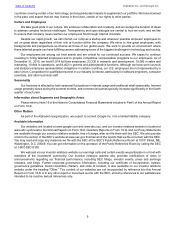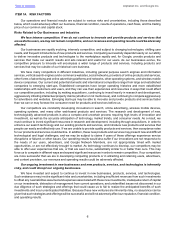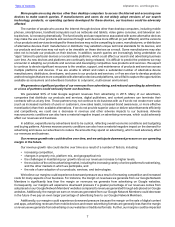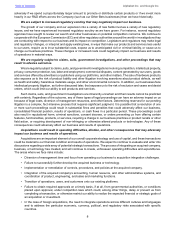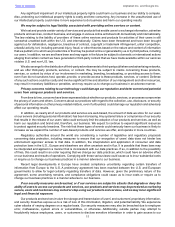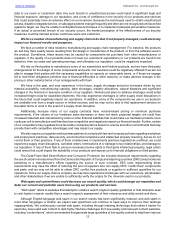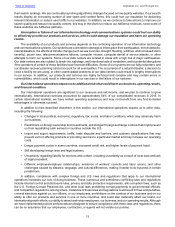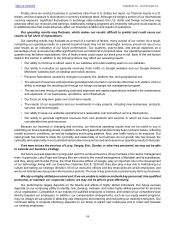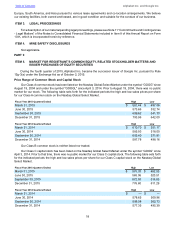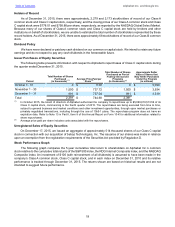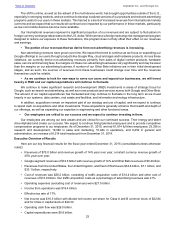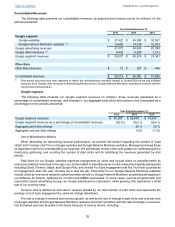Google 2015 Annual Report Download - page 19
Download and view the complete annual report
Please find page 19 of the 2015 Google annual report below. You can navigate through the pages in the report by either clicking on the pages listed below, or by using the keyword search tool below to find specific information within the annual report.
Table of Contents Alphabet Inc. and Google Inc.
15
In addition, we believe that our corporate culture fosters innovation, creativity, and teamwork. As our organization
grows, and we are required to implement more complex organizational management structures, particularly in light of
our holding company reorganization and new operating structure, we may find it increasingly difficult to maintain the
beneficial aspects of our corporate culture. This could negatively impact our future success.
Our business depends on continued and unimpeded access to the Internet by us and our users. Internet
access providers may be able to restrict, block, degrade, or charge for access to certain of our products and
services, which could lead to additional expenses and the loss of users and advertisers.
Our products and services depend on the ability of our users to access the Internet, and certain of our products
require significant bandwidth to work effectively. Currently, this access is provided by companies that have significant
market power in the broadband and internet access marketplace, including incumbent telephone companies, cable
companies, mobile communications companies, and government-owned service providers. Some of these providers
have taken, or have stated that they may take measures, including legal actions, that could degrade, disrupt, or increase
the cost of user access to certain of our products by restricting or prohibiting the use of their infrastructure to support
or facilitate our offerings, or by charging increased fees to us or our users to provide our offerings. In addition, in some
jurisdictions, our products and services have been subject to government-initiated restrictions or blockages. Such
interference could result in a loss of existing users and advertisers, and increased costs, and could impair our ability
to attract new users and advertisers, thereby harming our revenues and growth.
New technologies could block online ads, which would harm our Google business.
Technologies have been developed that can block the display of our ads and that provide tools to users to opt
out of our advertising products. Most of our Google revenues are derived from fees paid to us by advertisers in
connection with the display of ads on web pages for our users. As a result, such technologies and tools could adversely
affect our operating results.
We are exposed to fluctuations in the market values of our investments.
Given the global nature of our business, we have investments both domestically and internationally. Credit ratings
and market values of these investments can be negatively impacted by liquidity, credit deterioration or losses, financial
results, foreign exchange rates, or other factors. As a result, the value or liquidity of our cash equivalents and marketable
securities could decline and result in a material impairment, which could materially adversely affect our financial
condition and operating results.
We may have exposure to greater than anticipated tax liabilities.
Our future income taxes could be adversely affected by earnings being lower than anticipated in jurisdictions that
have lower statutory tax rates and higher than anticipated in jurisdictions that have higher statutory tax rates, the net
gains and losses recognized by legal entities on certain hedges and related hedged intercompany and other transactions
under our foreign exchange risk management program, changes in the valuation of our deferred tax assets or liabilities,
or changes in tax laws, regulations, or accounting principles, as well as certain discrete items. We are subject to regular
review and audit by both domestic and foreign tax authorities. As a result, we have received, and may in the future
receive, assessments in multiple jurisdictions on various tax-related assertions, including transfer pricing adjustments
or permanent establishment. Any adverse outcome of such a review or audit could have a negative effect on our
operating results and financial condition. In addition, the determination of our worldwide provision for income taxes
and other tax liabilities requires significant judgment, and there are many transactions and calculations where the
ultimate tax determination is uncertain. Although we believe our estimates are reasonable, the ultimate tax outcome
may differ from the amounts recorded in our financial statements and may materially affect our financial results in the
period or periods for which such determination is made.
Risks Related to Ownership of Our Stock
The trading price for our Class A common stock and non-voting Class C capital stock may continue to
be volatile.
The trading price of our stock has at times experienced substantial price volatility and may continue to be volatile.
For example, from January 1, 2015 through December 31, 2015, the closing price of our Class A common stock ranged
from $497.06 per share to $793.96 per share, and the closing price of our Class C capital stock ranged from $492.55
to $776.60 per share.
The trading price of our Class A common stock and Class C capital stock may fluctuate widely in response to
various factors, some of which are beyond our control. These factors include, among others:
• Quarterly variations in our results of operations or those of our competitors.


